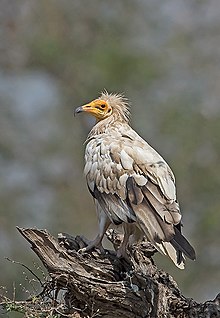| Egyptian vulture | |
|---|---|

| |
| Adult N. p. percnopterus in northern India | |
| Scientific classification | |
| Domain: | Eukaryota |
| Kingdom: | Animalia |
| Phylum: | Chordata |
| Class: | Aves |
| Order: | Accipitriformes |
| Family: | Accipitridae |
| Subfamily: | Gypaetinae |
| Genus: | Neophron Savigny, 1809 |
| Species: | N. percnopterus
|
| Binomial name | |
| Neophron percnopterus | |
| Subspecies[2] | |
| |

| |
| Distribution of the three subspecies | |
| Synonyms | |
|
Vultur percnopterus Linnaeus, 1758 | |
The Egyptian vulture (Neophron percnopterus), also called the white scavenger vulture or pharaoh's chicken, is a small Old World vulture in the monotypic genus Neophron. It is widely distributed from the Iberian Peninsula, North Africa, West Asia and India. The contrasting underwing pattern and wedge-shaped tail make it distinctive in flight as it soars in thermals during the warmer parts of the day. Egyptian vultures feed mainly on carrion but are opportunistic and will prey on small mammals, birds, and reptiles. They also feed on the eggs of other birds, breaking larger ones by tossing a large pebble onto them.
The use of tools is rare in birds and apart from the use of a pebble as a hammer, Egyptian vultures also use twigs to roll up wool for use in their nest. Egyptian vultures that breed in the temperate regions migrate south in winter while tropical populations are relatively sedentary. Populations of this species declined in the 20th century and some island populations are endangered by hunting, accidental poisoning, and collision with power lines.
- ^ a b BirdLife International (2021). "Neophron percnopterus". IUCN Red List of Threatened Species. 2021: e.T22695180A205187871. doi:10.2305/IUCN.UK.2021-3.RLTS.T22695180A205187871.en. Retrieved 4 October 2024.
- ^ Gill F, D Donsker & P Rasmussen (Eds). 2020. IOC World Bird List (v10.2).doi:10.14344/IOC.ML.10.2.
